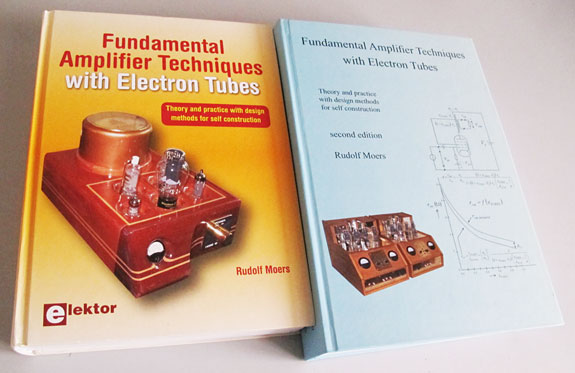|
|
Home | High-End Audio Reviews | Audiophile Shows | Partner Mags | Hi-Fi / Music News |
|
|
|
30 Years Of Service To Music Lovers |
|
|
November 2018
![]()
Fundamental Amplifier Techniques With Electron Tubes
Second Edition
Theory and practice with design methods for self construction.
Book By Rudolf Moers

This is not a DIY book with ready-made electron tube amplifier designs which one can copy, paste and eventually edit into a practical construction. No fancy tone control designs and esoteric RIAA filters are included. There are no modifications of high-fidelity tube amplifiers into guitar tube amplifiers. An OTL amplifier is mentioned once, and the use of a soldering iron starts at the end of an electron tube amplifier design.
Fundamental Amplifier Techniques With Electron Tubes is a text book that comprehensively covers the area of electron tube amplifiers. Because it contains a fair amount of technical jargon and detailed illustrations, the reader does require a knowledge of electronics and mathematics.
The book seeks to address two aspects of technical books that readers appreciate. Namely accuracy and a pleasant readability. Those readers interested only in formulae that provide a valid 'recipe' can skip its derivation without compromising the story's readability. These 'recipes' are framed at the end of formula derivations, are easy to recognize and to apply in practice.

However, there are readers who are not looking for formulae that 'fall from the sky' without derivation. To them, a 'recipe' without substantiation is unsatisfactory, and the application of the formulae is accepted only when the derivation is clearly described and understood. In this book, formula derivations are presented and proved in an easy-to-follow manner.
Almost all circuits or circuit parts are translated into equivalent circuits which are analyzed using network theory and mathematics. The results of the corresponding formula derivations, which are framed as a 'recipe', are put to the test in practice.
Following on from the introduction in Chapter 1, Chapter 2 describes the principles of electron emission. Chapters 3, 4, 5 and 6 deal with the diode, triode, tetrode and pentode respectively, each of a different construction. They are covered only at mid-frequencies, minus any discussion of distortion and negative feedback. Chapter 7 discusses the limits of audio frequencies, and chapter 8 covers the topics of non-linear distortion and noise. Chapter 9 concerns negative feedback, and Chapter 10 describes how to build your own electron tube amplifier. This book does cover a lot of information.
So it is recommended to use the Table of Contents (TOC available here in PDF)

This second edition on 'tubed audio' is as thick as your 12AX7 / ECC83 tube is tall! A must-have for all tube fans and the growing circle of RAF's (retro-audio-aficionado's). Rudolf Moers's 'opus magnum' is again available in English. In a mind-blowing 900+ pages, Rudolf covers just about everything you need to know about the fundamentals of electron tubes and the way these wonderful devices were designed to function at their best in their best known application: the (now vintage) electron tube audio amplifier.
The books aim is to give the reader useful knowledge about electron tube technology in the application of audio amplifiers, including their power supplies, for the design and DIY construction of these electron tube amplifiers. This is much more than just building an electron tube amplifier from a schematic made from the design from someone else: no academic theory for scientific evidence, but a theoretical explanation of how the practice works. No modern simulations, but because you first understand the circuit calculations, you can then work with your hands to build the circuit and last but not least, if you have a multimeter, a signal generator and an oscilloscope, you can measure the circuit parameters yourself to check how closely theory and practice match. All this is what makes this book a unique reference source.

Book excerpt in PDF available here.
The book specifications are:
ISBN : 978-94-6345-175-8
Pages: 922 (88 more pages than the first edition)
Size: 21.4 x 30.3 x 6.4 cm (A4)
Weight: 2.9 kg (0.5 kg more than the first edition)
Price: €59 (€16 less than the first edition)
Order: www.boekenbestellen.nl
(in Dutch, Englisch, German and French, select the county flags)
A fast link to order (in Dutch, Englisch, German and French, select the county
flags)
www.boekenbestellen.nl/boek/fundamental...

 High-Performance Audio Reviews
High-Performance Audio Reviews













